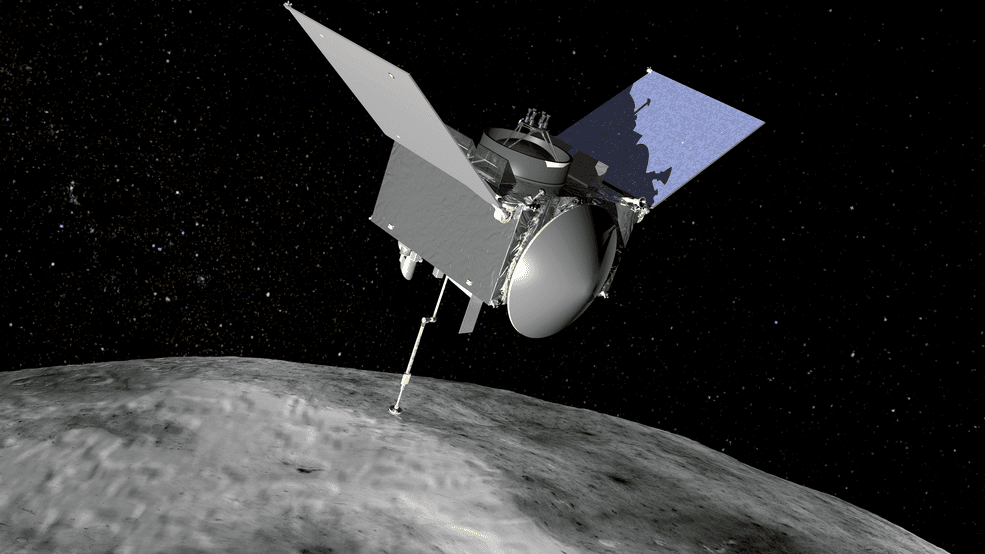NASA is preparing for a potentially game-changing mission: intercepting an asteroid and bringing a sample back home.

Credits: NASA
The asteroid is called Bennu, and the space shuttle is called OSIRIS-REx — short for “Origins, Spectral Interpretation, Resource Identification, Security – Regolith Explorer.” Bennu and OSIRIS-REx are set for a date in mid-2018, where Bennu will do a little hit-and-run: it will lightly graze the asteroid, take a sample and hopefully return it back to Earth.
“This mission exemplifies our nation’s quest to boldly go and study our solar system and beyond to better understand the universe and our place in it,” said Geoff Yoder, acting associate administrator for the agency’s Science Mission Directorate in Washington.
“NASA science is the greatest engine of scientific discovery on the planet and OSIRIS-REx embodies our directorate’s goal to innovate, explore, discover, and inspire.”
Bennu and OSIRIS-REx
The asteroid Bennu is basically a big pile of dirt, but it’s a special pile of dirt. Astronomers believe that the asteroid has been around for over 4.5 billion years, from the earliest days of our solar system. This would mean that it still carries around very valuable information from the time, and this is exactly why astrophysicist Christina Richey is excited to get a shuttle there.
“That’s a level of understanding we don’t have on Earth right now, and that’s something we really need,” says Richey. She’s one of the people at NASA coordinating the mission, which is called OSIRIS-REx — short for “Origins, Spectral Interpretation, Resource Identification, Security – Regolith Explorer.”
She and her colleagues believe that the asteroid (like several others) contains carbon molecules which were crucial in life emerging on planet Earth. In other words, they may have seeded Earth with carbon. There’s another reason why they chose this asteroid specifically: at the end of the next century, the Bennu will arrive very close to Earth, and even smack into it.

Don’t panic just yet, there’s a 99% chance that won’t happen, but either way it’s good to keep an eye on it, and the mission will give us a better understanding of its trajectory.
It’s not the first mission of this kind. In 2010, a Japanese mission also brought back a tiny sample and the second part of the mission, which aims to bring a more consistent sample is already underway. Also, in 2006, in 2006, NASA’s Stardust mission scooped up ancient dust from a comet.
“This is kind of like a follow-on to Stardust,” Richey says, “only with a way larger sample and with an asteroid versus a comet.”
But the mission will take a lot of time – seven years to be more precise. After a careful survey of Bennu to characterize the asteroid and locate the most promising sample sites, OSIRIS-REx will collect between 2 and 70 ounces (about 60 to 2,000 grams) of surface material with its robotic arm and return the sample to Earth via a detachable capsule in 2023.
“The launch of OSIRIS-REx is the beginning a seven-year journey to return pristine samples from asteroid Bennu,” said OSIRIS-REx Principal Investigator Dante Lauretta of the University of Arizona, Tucson. “The team has built an amazing spacecraft, and we are well-equipped to investigate Bennu and return with our scientific treasure.”
According to NASA, there are five scientific instruments which OSIRIS-REx will use on the asteroid, aside from the sample collection tools:
- OSIRIS-REx Camera Suite (OCAMS) – A system consisting of three cameras provided by the University of Arizona, Tucson, will observe Bennu and provide global imaging, sample site imaging, and will witness the sampling event.
- OSIRIS-REx Laser Altimeter (OLA) – A scanning LIDAR (Light Detection and Ranging) contributed by the Canadian Space Agency will be used to measure the distance between the spacecraft and Bennu’s surface, and will map the shape of the asteroid.
- OSIRIS-REx Thermal Emission Spectrometer (OTES) – An instrument provided by Arizona State University in Tempe that will investigate mineral abundances and provide temperature information with observations in the thermal infrared spectrum.
- OSIRIS-REx Visible and Infrared Spectrometer (OVIRS) – An instrument provided by NASA’s Goddard Space Flight Center in Greenbelt, Maryland and designed to measure visible and infrared light from Bennu to identify mineral and organic material.
- Regolith X-ray Imaging Spectrometer (REXIS) – A student experiment provided by the Massachusetts Institute of Technology (MIT) and Harvard University in Cambridge, which will observe the X-ray spectrum to identify chemical elements on Bennu’s surface and their abundances.






